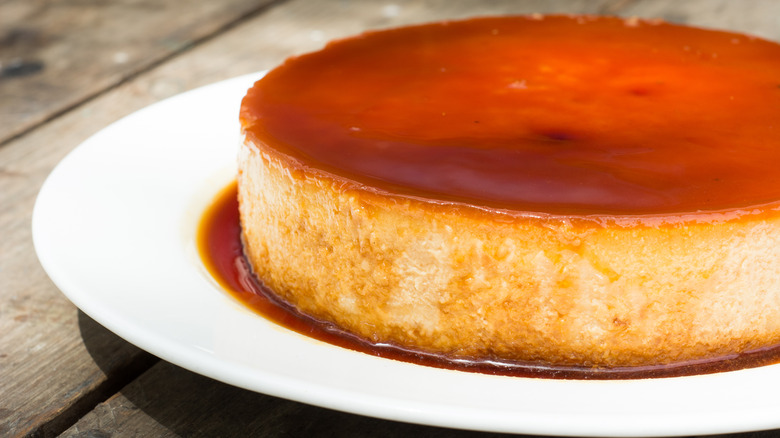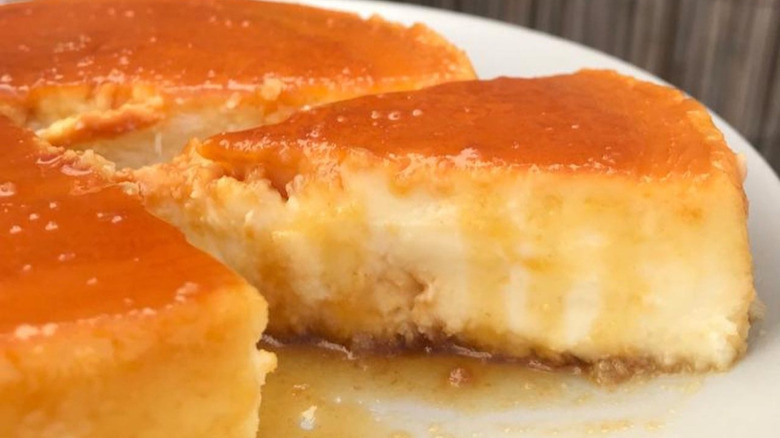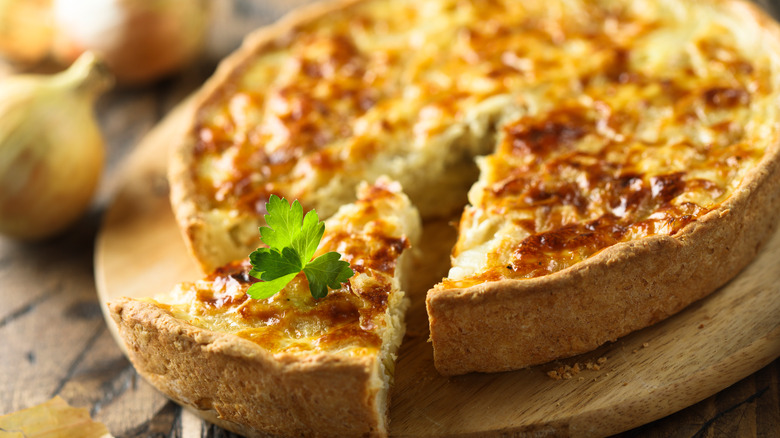Flan De Queso Is The Cheesy Dessert We Need
Dessert typically appeals to those with a sweet tooth, but flan de queso adds a savory ingredient to a beloved classic: cheese. Combining the smooth, creamy custard with a cheesy flavor strikes the right balance, offering something that's not too sweet but still fits the bill for dessert. Adding queso gives flan a texture and taste similar to that of cheesecake, resulting in a delicious hybrid of both desserts.
flan de queso utilizes the ingredients of a classic flan recipe — eggs, condensed milk, evaporated milk, vanilla extract, and a caramel topping — and adds cream cheese to the mix. The cream cheese is blended with the milk, vanilla, and eggs. This blend is poured over the cooled caramel topping in a mold or pan. It's then set in a water bath and placed in the oven for 45 minutes to a little over an hour. Once the flan is finished cooking, it's cooled in the refrigerator.
The amount of cream cheese added to flan de queso depends on the recipe, but most recommend using a full 8-ounce package. It's also important to ensure the cream cheese is softened before mixing it with the other ingredients. Otherwise, the flan de queso's texture will be compromised — and that can make or break a homemade flan.
Where to find flan de queso
There's no grand origin story for flan de queso, and it's hard to pinpoint where the revamped dessert first emerged (though it likely hails from either Spain or Mexico). Flan itself goes all the way back to the Roman Empire, though the Romans made theirs more savory than sweet, often using fish in the dish. In some ways, flan de queso brings the dessert back to its roots.
Flan made its way to Spain when the Roman Empire conquered Europe, and that's where it began it's transformation into the dessert we know today. Spain is responsible for adding caramel to the dish, and brought flan to Mexico, where it's become an everyday staple. The custard dish eventually made its way to the Americas as well. Those visiting Mexico will find variations of the custard while dining out there, including flan de queso.
Restaurants serving Spanish or Mexican cuisine tend to have flan on their dessert menus. They'll likely specify if it's made with cream cheese, but unfortunately, flan de queso still isn't as common as regular flan. Fortunately, flan de queso is simple enough to make at home. Like flan, it only requires a few ingredients and the know-how to put them together.
Variations of flan de queso can make it more savory
The average flan de queso still fits firmly into the dessert category, adding cream cheese to an otherwise sweet dish. Cottage cheese or ricotta can be used to similar effect. Depending on your inspirations, you might switch up other ingredients as well. You can use egg yolks instead of whole eggs, resulting in a denser custard overall. You also might replace condensed milk with evaporated for a less sweet taste. These variations will keep your flan in dessert territory, even as they bring their own unique spins to the dish. However, it's possible to go more savory — and cream cheese can work just as well with such a change.
Although some might argue that there's a difference between quiche and flan, there are some versions of flan de queso that are very similar to quiche. Quiche tends to be more savory, utilizing eggs, meat, and vegetables in its base. In savory flans, cheeses like cheddar can be added to the dish, making the flavor from the queso more pronounced. However, it's also possible to add cream cheese to a quiche recipe, giving it a smoother texture rather than an eggy one. This would work well with quiche that contains typical breakfast items like bacon and sausage. It would also complement a spinach or loaded veggie quiche. This spinoff of flan de queso certainly won't satisfy sugar cravings. Still, it will taste decadent and pack a creamy, cheesy punch.


